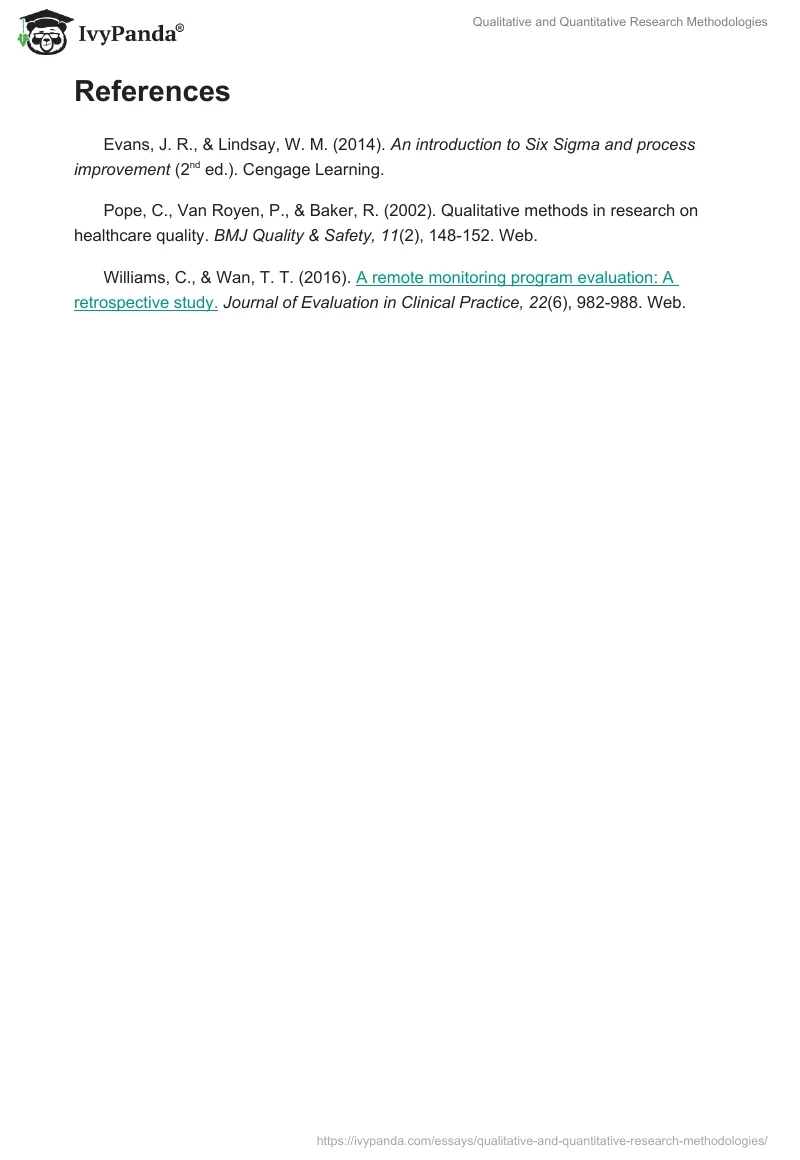Qualitative and quantitative research methods align closely with the principles of Six Sigma, Lean, and Lean Six Sigma. Evans and Lindsay (2014) state that to apply and implement Six Sigma, practitioners should use both the “hard” and the “soft” disciplines, which can be reflected in quantitative and qualitative methods (p. 27). Qualitative methods involve collecting and analyzing textual material obtained from interviews and observation and assist in quality assessment and improvement (Pope et al., 2002). Similarly, Six Sigma’s tools and techniques are used in quality improvement and help to handle management and organizational issues (Evans & Lindsay, 2014). Williams and Wan (2016) examine a heart disease management program based on a quantitative research method and suggest using measurable numerical data for performance evaluation. Likewise, Six Sigma presents the use of advanced statistical methods, such as the design of experiments, that can be integrated into management systems (Evans & Lindsay, 2014). Six Sigma can incorporate qualitative and quantitative research methods to identify an organization’s problems.
Quantitative and qualitative methods align with Lean and Lean Six Sigma through the latter’s connections with Six Sigma. Six Sigma is traditionally most applicable to conformance issues, but lean tools are typically used for efficiency problems (Evans & Lindsay, 2014). Lean principles concentrate on eliminating waste and efficient flow of information and materials by using tools like 5S, which represents a system for workplace organization and standardization (Evans & Lindsay, 2014). Qualitative methods also assist in transforming systems and can provide insights into policy implementation (Pope et al., 2002). Lean Six Sigma emerged from a combination of Lean and Six Sigma and is used for overall improvement based on reducing defects and waste (Evans & Lindsay, 2014). While Six Sigma can use quantitative and qualitative methods, it seems to prioritize statistics, graphs, and charts (Evans & Lindsay, 2014). Pope et al. (2002) propose that, although qualitative research can be independent, it is also “a complement to quantitative studies” (p. 148). Therefore, qualitative and quantitative methods are different, but they should be employed jointly to enhance an organization’s performance, especially when utilizing Lean Six Sigma.
References
Evans, J. R., & Lindsay, W. M. (2014). An introduction to Six Sigma and process improvement (2nd ed.). Cengage Learning.
Pope, C., Van Royen, P., & Baker, R. (2002). Qualitative methods in research on healthcare quality. BMJ Quality & Safety, 11(2), 148-152. Web.
Williams, C., & Wan, T. T. (2016). A remote monitoring program evaluation: A retrospective study.Journal of Evaluation in Clinical Practice, 22(6), 982-988. Web.


